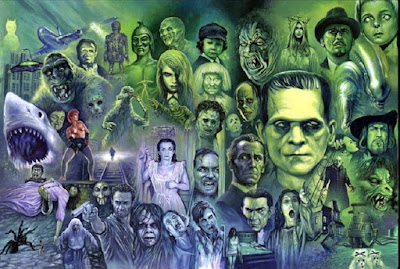Copyright 2020 by Gary L. Pullman
Sult
(2018), a Norwegian short erotic horror film runs about seven minutes
and thirty-six minutes (not counting the credits that roll as the end
of the action). In English, the movie's title is Hunger. A
brunette hairstylist, Vera (Sarah-Stephanie Skjoldevik) has an
appetite for an aloof blonde, Suzanne (Marianne Lindbeck), but Vera's
love, if not her passion, is unrequited. However, Suzanne does seem
attracted to brunettes: the woman with whom she cheats on Vera is
also a dark-haired beauty.

The film starts in the present.
It's Friday, and Vera joins Suzanne in a booth in a bar. Suzanne
wears the necklace that Vera gives her (in a flashback scene not yet
shown). Suzanne does not look overjoyed to see Vera; in fact, Suzanne
appears barely able to tolerate the brunette. Vera drinks a glass of
wine on the rim of which is a split cherry. Then, Vera strokes
Suzanne's cheek, throat, and chin, as Suzanne appears to put up with
Vera's attentions, rather than to enjoy them. However, when Vera
kisses Suzanne, the women exchange a series of additional kisses,
during which Suzanne, becoming aroused, slips the tip of her tongue
into Vera's mouth. Reaching behind her own back, Vera removes a pair
of scissors from her waistband. Biting Suzanne's tongue, Vera snips
the tip of it off with her scissors, and Suzanne falls back, against
the seat in the booth, a bloody mess, in pain, disbelief, and horror.

During a flashback, Vera is at
home. It's Tuesday, and she prepares for her date with Suzanne.
Later, they play billiards, and Suzanne wins. Afterward, Vera gives
Suzanne a necklace—the same one the blonde wears in the bar in the
film's opening scene. However, Vera seems indifferent about the
gift—she even rolls her eyes as Vera fastens it about her neck—and,
indeed, Suzanne seems to care nothing for Vera's love for her. The
next day, Vera visits Suzanne's modest apartment, where the brunette
sees Suzanne kissing and caressing another woman, who is also a
brunette. On Thursday, while styling a client's hair, Vera cuts her
finger, which seems to suggest the revenge she takes upon Suzanne.
Back in the present, watching
Suzanne bleed and shudder, Vera, now shows the same indifference
toward Suzanne's pain and horror as Suzanne had earlier shown
concerning Vera's gift. After retrieving the necklace she'd given
Suzanne, Vera takes the tip of Suzanne's tongue from Suzanne's bloody
hand, inserts the severed piece of the appendage into her own mouth,
chews, and swallows, before abandoning Suzanne, who continues to
bleed and shudder in the booth.

Sult
is a revenge film, but there is a bit more to the interpersonal
dynamics between Vera and Suzanne than simply courtship. When she
meets Suzanne in the bar, Vera wears a black leather outfit that
suggests a penchant on her part for BDSM. In a stereotype dating from
pulp fiction lesbian erotica, Vera's hair color and dress
characterize her as a dominant, or top, while Suzanne's contrasting
blonde locks identify her as a submissive, or bottom. Throughout the
film Vera displays her dominance over Suzanne. She makes Suzanne wait
for her to arrive at the bar. Vera always initiates the action
between them. Vera gazes upon Suzanne as though the blonde is a
prized possession, rather than a person. Vera bestows a gift upon
Suzanne, which identifies the blonde as the recipient of Vera's
generosity.
Suzanne
maintains a relationship with Vera, but it is a superficial one. She
tolerates Vera, but she does not love her. She waits for her. She
endures Vera's kisses and caresses, but she never initiates the
intimacy between them, and she does not appear to treasure the gift
of the necklace. She accepts it the same was that she tolerates Vera,
with aloofness, with coolness, with indifference. She even expresses
her disdain by rolling her eyes as Vera fastens the clasp of the
necklace about her lover's neck. There is the suggestion, in Vera's
large, luxurious apartment, in her clothing, in her gift, and in her
bearing, of a woman who has money, but she is a controlled, as well
as a controlling, mistress: she wears tight, restrictive clothing—the
leather outfit and the corset into which she laces herself quite
tightly as she prepares for her date with Suzanne.
It
is because of Vera's money, rather than for Vera herself, perhaps,
that Suzanne unenthusiastically tolerates Vera and her romantic
inclinations. It is clear, though, that Suzanne does not love Vera,
despite the occasional passion that Vera's lovemaking ignites in
Suzanne.
Certainly,
Vera is not Suzanne's only paramour. Suzanne embraces, kisses, and
caresses the woman in her own apartment, and, although Vera later
watches Suzanne grope and be groped by another woman—a brunette,
like Vera herself—and pleasures herself, it is clear that Vera does
not like sharing Suzanne with someone else.
Suzanne's
intimate interaction with the other woman also suggests that Suzanne
is not exclusively submissive, for, in these interactions, Suzanne
not only takes the lead, but she treats her lover in a manner similar
to the one in which Vera treats Suzanne herself: Suzanne, in these
interactions, is the dominant person. With Vera, she reverses this
role, albeit reluctantly. Suzanne, like Vera, appears to be a
naturally dominant person. If such is the case, she may well resent
submitting to Vera, which could explain Suzanne's reluctance and
indifference to her playing the role of the submissive participant in
her relationship with Vera.

It
is when Vera accidentally cuts herself while styling another woman's
hair—and a blonde woman, like Suzanne, at that—that Vera
conceives her plan to cut off the tip of Suzanne's tongue. She will
punish Suzanne's infidelity. She will hurt Suzanne, as Vera has just
hurt herself. Indeed, the same pair of scissors with which she
accidentally cut her own finger become the instrument with which she
severs Suzanne's tongue.
The
tongue is an instrument of taste. It is an instrument of
communication, helping to form words. The lips resemble the labia,
and, in lesbian lovemaking, the lips are often a primary instrument
in providing pleasure for one's lover—in Suzanne's case, Vera.
However, Suzanne has betrayed Vera with her lips and her tongue,
kissing other women, women with whom Suzanne takes the lead, acting
as the initiator, conducting herself in an aggressive, dominant
manner.
By
cutting off the tip of Suzanne's tongue, Vera mutilates her,
degrading Suzanne's beauty while eliminating or severely reducing
Suzanne's ability to provide erotic pleasure to other lovers. In a
sense, by this act, Vera claims Suzanne as her own. However, she does
so only to abandon her, to leave her moaning in horror and pain,
shuddering and bloody. Henceforth, if she survives, Suzanne will be
less beautiful and less able to attract and please other women.
The
“hunger” that Vera feels for Suzanne is sexual, but it is also
psychological. Vera wants Suzanne both physically and emotionally.
Vera wants to dominate Suzanne, body and soul, When Suzanne refuses
to give Vera what she wants most—her autonomy, her freedom, her
will, her very existence—Vera takes it. Courtship becomes assault,
physical, sexual, and emotional.
In
certain societies, consuming part of a vanquished enemy's
body—usually, the heart—indicates that the consumer has ingested
the foe's courage, literally taking it into himself, so that the
enemy's attribute becomes an attribute of the vanquishing hero
himself. By eating the tip of Suzanne's tongue, Vera symbolically
takes into herself Suzanne's own beauty and passion; Suzanne's
characteristics become Vera's own. It is the final act of dominance,
of control, of possession.
The
question is, Does the cannibalistic act satisfy Vera's hunger? Can
such a hunger ever be satisfied? Will Vera, at some time in
the future, become hungry again?




















































